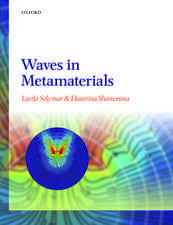Relaxation and Diffusion in Complex Systems: Partially Ordered Systems
Autor K. L. Ngaien Limba Engleză Hardback – 22 apr 2011
| Toate formatele și edițiile | Preț | Express |
|---|---|---|
| Paperback (1) | 1570.03 lei 6-8 săpt. | |
| Springer – 23 aug 2016 | 1570.03 lei 6-8 săpt. | |
| Hardback (1) | 1584.08 lei 6-8 săpt. | |
| Springer – 22 apr 2011 | 1584.08 lei 6-8 săpt. |
Preț: 1584.08 lei
Preț vechi: 1931.81 lei
-18% Nou
Puncte Express: 2376
Preț estimativ în valută:
303.10€ • 316.50$ • 250.30£
303.10€ • 316.50$ • 250.30£
Carte tipărită la comandă
Livrare economică 15-29 aprilie
Preluare comenzi: 021 569.72.76
Specificații
ISBN-13: 9781441976482
ISBN-10: 1441976485
Pagini: 650
Ilustrații: XXI, 835 p.
Dimensiuni: 155 x 235 x 53 mm
Greutate: 1.58 kg
Ediția:2011
Editura: Springer
Colecția Springer
Seria Partially Ordered Systems
Locul publicării:New York, NY, United States
ISBN-10: 1441976485
Pagini: 650
Ilustrații: XXI, 835 p.
Dimensiuni: 155 x 235 x 53 mm
Greutate: 1.58 kg
Ediția:2011
Editura: Springer
Colecția Springer
Seria Partially Ordered Systems
Locul publicării:New York, NY, United States
Public țintă
ResearchCuprins
Introduction.- Universal Relaxation and Diffusion Properties in Complex Systems.- Experimental Evidences.- Computer Simulations.- Theoretical Modeling and Interpretations.- Many-Body Relaxation Dynamic and Relation to Chaos.- Glass Transition and the Glassy State.- Role of Thermodynamics, Volume, Entropy and Temperature.- Polymer Viscoelasticity.- Ionic Conductivity Relaxation in Ionically Conducting Materials.- Relaxation and Diffusion at Nanometer Scales.- Relaxation in Biomolecules.
Notă biografică
Dr. Kia L. Ngai has worked in relaxation and diffusion in disordered and partially ordered systems across many disciplines for 25 years. He has authored or co-authored over 300 publications in archival journals. His works have been cited widely.Dr. Ngai has also written a chapter in the textbook, Physical Properties of Polymers, 3rd edition (Cambridge University Press, 2003); two chapters in Physical Properties of Polymers Handbook, edited by James E. Mark (Springer), and a chapter in Science and Technology of Rubber (Elsevier). He was the originator and organizer of the following large-scale international conference series entitled "International Discussion Meeting on Relaxations in Complex Systems": 1990, Herklion, Crete, Greece; 1993, Alicante, Spain; 1997 Vigo, Spain; 2001, Hersonissos, Crete, Greece; and 2005, Lille, France. I served as the editor of the Proceedings of each of these Meetings. The proceedings are published as refereed papers in the Journal of Non-Crystalline Solids (Elsevier) in 1991, 1994, 1998 and 2002.
Textul de pe ultima copertă
Relaxation and Diffusion in Complex Systems comprehensively presents a variety of experimental evidences of universal relaxation and diffusion properties in complex materials and systems. The materials discussed include liquids, glasses, colloids, polymers, rubbers, plastic crystals and aqueous mixtures, as well as carbohydrates, biomolecules, bioprotectants and pharmaceuticals. Due to the abundance of experimental data, emphasis is placed on glass-formers and the glass transition problem, a still unsolved problem in condensed matter physics and chemistry.The evidence for universal properties of relaxation and diffusion dynamics suggests that a fundamental physical law is at work. The origin of the universal properties is traced to the many-body effects of the interaction, rigorous theory of which does not exist at the present time. However, using solutions of simplified models as guides, key quantities have been identified and predictions of the universal properties generated. These predictions from Ngai’s Coupling Model can qualitatively as well as quantitatively explain the experimentally observed dynamic properties of different complex interacting materials and systems in many cases, essentially from the strength of the interaction. Change of relaxation and diffusion dynamics when dimension of the material is reduced to nanometer scale are consistent with the predictions. The success of the Coupling Model provides some measure of understanding the relaxation properties of complex interacting systems and also paves the way for the construction of rigorous theories in the future.Relaxation and Diffusion in Complex Systems describes advances that affect many different areas of research, and will be of particular interest to those working in the fields of materials science, nanotechnology, energy and medicine.
Caracteristici
Exposes the reader to many different classes of materials and relaxation phenomena A thorough treatment of the Glass Transition Problem With over 1800 references and hundreds of figures, this book collects the results of many experiments and illustrates the universal behavior of relaxation and diffusion in interacting systems Includes supplementary material: sn.pub/extras



























